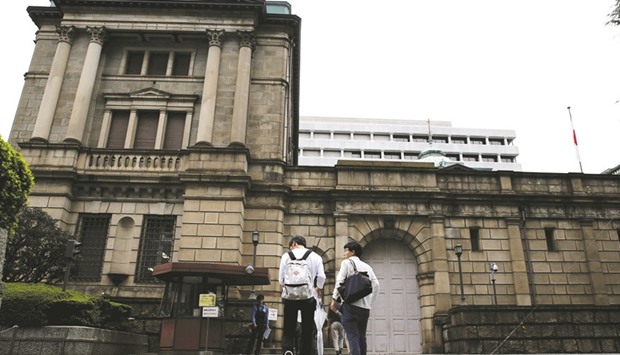Japan needs a double dose of monetary and fiscal stimulus, including further easing by the central bank next month, says Etsuro Honda, one of Prime Minister Shinzo Abe’s economic advisers.
Honda, one of the architects of Abenomics, said fiscal restraint had limited the effectiveness of the Bank of Japan’s radical monetary easing, and was the biggest reason inflation hadn’t risen to the central bank’s 2% target despite more than three years of aggressive easing under Governor Haruhiko Kuroda.
He said he told Abe during a meeting in Tokyo on September 28 that monetary and fiscal policy should be managed in a unified manner.
“Japan has tightened its fiscal grip, so the primary effectiveness of monetary policy could not be exerted,” Honda, 61, said during a telephone interview on Thursday from Switzerland, where he serves as Japan’s ambassador. “I want the government to make aggressive use of fiscal spending in order to strengthen the effectiveness of monetary policy.”
Japan’s Cabinet in August approved a second supplementary budget that included a ¥28tn economic stimulus package. Honda said the government, one of the developed world’s most indebted, should consider a third supplementary budget during the current fiscal year ending in March.
Honda said the BoJ needs to ease further at its next policy meeting ending November 1.
He said the BoJ could still increase its purchases of Japanese government bonds and deepen the negative interest rate on some bank reserves, though it would be better to wait until the yield curve steepens to cut the rate further.
At its last meeting on September 21, the BoJ shifted the focus of its monetary stimulus from expanding the money supply to controlling interest rates, pledging to pin benchmark 10-year yields around zero.
The central bank strengthened its forward guidance by vowing to continue expanding the monetary base until inflation is stable above the 2% target - committing to an overshoot of consumer-price gains in an effort to revive inflation expectations. The BoJ will hold a policy meeting on October 31 and November 1.
Some economists have suggested the BoJ’s regime change will amount to a stealth tapering of the monetary-base expansion, since the BoJ has acknowledged that its asset purchases would fluctuate as necessary to hit its interest-rate targets.
The BoJ’s shift meant “those who support quantitative easing were defeated,” Nobuyuki Nakahara, who has advised the prime minister on the economy and was an intellectual father of the BoJ’s first run at quantitative easing in 2001, said in a September 30 interview. Honda said he told Abe during their 15-minute meeting on September 28 that the BoJ’s new framework was “appropriate” and wasn’t tapering, and that further easing would be needed.
“I told him that the BoJ’s policy target has changed but the regime of Abenomics hasn’t changed,” Honda said. “What I wanted to say the most was about managing fiscal and monetary policies in a unified manner. Japan should not be afraid of increasing bond issuance.”
Kuroda has less than 19 months remaining in his term. While no BoJ governor has been tapped for a second five-year term since the 1960s, Kuroda’s central role in Abenomics has led to speculation that he may be different.
Whether Kuroda will be reappointed to another term will be up to Abe, Honda said.
“I’m not sure whether reappointment would be appropriate or not, but what he is doing is appropriate,” Honda said. “If I were to dare say, it would have been better if the BoJ took one step further to give a stronger signal about further easing” at the September meeting.
Honda said the BoJ still has the option of buying foreign bonds as part of its asset-purchase program, but shouldn’t do so now because it would risk accusations of currency intervention to stem the yen’s strength.
The yen has gained more than 15% against the dollar this year, hurting corporate profits and pushing down import prices, making it more difficult for the BoJ to generate inflation. The yen traded at 103.64 versus the dollar in Tokyo on Friday.
Honda said the yen’s gains had been excessive and a move past 100 versus the dollar would spur more concerns about Japan’s economy and prices.

Men walk towards the Bank of Japan building in Tokyo. At its last meeting on September 21, the BoJ shifted the focus of its monetary stimulus from expanding the money supply to controlling interest rates, pledging to pin benchmark 10-year yields around zero.


